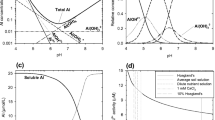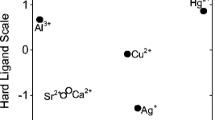Abstract
Aims
Root elongation tests are sensitive bioassays for testing metal toxicity in nutrient solutions. The metal speciation and, hence, metal exposure conditions are little controlled in the traditional set-up. A resin buffered solution system was developed to overcome this issue.
Methods
Barley (Hordeum vulgare L.) root elongation was tested in aerated 140 mL solution batch systems supplied with 3.3 g Dowex resin for two plants. Copper toxicity was measured in presence or absence of the resin (+R/−R) and in presence or absence of a metal complexing ligand (+NTA; nitrilotriacetic acid/−NTA). In addition, the toxicity in the traditional set without resin and with daily solution replacement was included as a reference.
Results
Metal desorption from the resin is fast in these systems (k = 0.82 h−1). Total dissolved Cu roughly halved during 4 days in −R/−NTA systems due to uptake, while it increased by 30 % in the +R/−NTA, probably due to complexation reactions by root-derived molecules. The toxicity (50 % reduction in root length, EC50) of the initial free Cu2+ was equal in all resin or chelate buffered systems and in the solutions with daily replacement, whereas this threshold was significantly larger in the −R/−NTA due to Cu2+ uptake and complexation reactions.
Conclusion
The resin method is a convenient system for high throughput screening of metal toxicity and avoids uncertainties in metal speciation inherent to chelator buffered systems. Details are given how to prepare the resin to obtain a target metal ion activity.



Similar content being viewed by others
References
Allen HE, Hall RH, Brisbin TD (1980) Metal speciation. Effects on aquatic toxicity. Environ Sci Technol 14:441–443
Anderegg G (1982) Critical survey of stability-constants of NTA complexes. Pure Appl Chem 54(12):2693–2758. doi:10.1351/pac198254122693
Bell PF, Chaney RL, Angle JS (1991) Free metal activity and total metal concentrations as indices of micronutrient availability to barley (Hordeum vulgare (L.) ‘Klages’). Plant Soil 130:51–62
Brain P, Cousens R (1989) An equation to describe dose responses where there is stimulation of growth at low-doses. Weed Res 29(2):93–96. doi:10.1111/j.1365-3180.1989.b00845.x
Chaney RL (1988) Plant can utilize iron from Fe-N, N’-Di-(2-Hydroxybenzoyl)-ethylenediamine-N, N’-diacetic acid, a ferric chelate with 106 greater formation constant than Fe-EDDHA. J Plant Nutr 11:1033–1050
Checkai RT, Corey RB, Helmke PA (1987a) Effects of ionic and complexed metal concentrations on plant uptake of cadmium and micronutrient metals from solution. Plant Soil 99:335–345
Checkai RT, Hendrickson LL, Corey RB, Helmke PA (1987b) A method for controlling the activities of free metal, hydrogen and phosphate ions in hydroponic solutions using ion exchange and chelating resins. Plant Soil 99:321–334
Cheung YH, Wong MH, Tam NFY (1989) Root en shoot elongation as an assessment of heavy-metal toxicity and Zn equivalent value of edible crops. Hydrobiologia 188:377–383. doi:10.1007/bf00027803
Degryse F, Smolders E, Parker DR (2006) Metal complexes increase uptake of Zn and Cu by plants: implications for uptake and deficiency studies in chelator-buffered solutions. Plant Soil 289(1–2):171–185
Degryse F, Verma VK, Smolders E (2008) Mobilization of Cu and Zn by root exudates of dicotyledonous plants in resin-buffered solutions and in soil. Plant Soil 306(1–2):69–84
Knezevic SZ, Streibig JC, Ritz C (2007) Utilizing R software package for dose–response studies: the concept and data analysis. Weed Technol 21(3):840–848. doi:10.1614/wt-06-161.1
Kopittke PM, Menzies NW (2006) Effect of Cu toxicity on growth of cowpea (Vigna unguiculata). Plant Soil 279(1–2):287–296. doi:10.1007/s11104-005-1578-z
Lock K, Criel P, De Schamphelaere KAC, Van Eeckhout H, Janssen CR (2007) Influence of calcium, magnesium, sodium, potassium and pH on copper toxicity to barley (Hordeum vulgare). Ecotoxicol Environ Saf 68(2):299–304. doi:10.1016/j.ecoenv.2006.11.014
Marschner H (1995) Mineral nutrition of higher plants. Academic, London
Parker DR, Chaney RL, Norvell WA (1995) Chemical equilibrium models: applications to plant nutrition research. In: Chemical equilibrium and reaction models. Soil Sci Soc Am, Madison, pp 163–200
Ritz C, Streibig JC (2005) Bioassay analysis using R. J Stat Softw 12(5):1–22
Seefeldt SS, Jensen JE, Fuerst EP (1995) Log-logistic analysis of herbicide dose–response relationships. Weed Technol 9(2):218–227
Sheldon AR, Menzies NW (2005) The effect of copper toxicity on the growth and root morphology of Rhodes grass (Chloris gayana Knuth.) in resin buffered solution culture. Plant Soil 278(1–2):341–349. doi:10.1007/s11104-005-8815-3
Smolders E, McLaughlin MJ (1996) Chloride increases cadmium uptake in Swiss Chard in a resin- buffered nutrient solution. Soil Sci Soc Am J 60(5):1443–1447
Vanewijk PH, Hoekstra JA (1993) Calculation of the EC50 and its confidence—interval when subtoxic stimulus is present. Ecotoxicol Environ Saf 25(1):25–32. doi:10.1006/eesa.1993.1003
Verheyen L, Merckx R, Smolders E (2012) A resin-buffered nutrient solution for controlling metal speciation in the algal bottle assay. Aquat Toxicol 114–115:200–205
Wang X, Hua L, Ma Y (2012) A biotic ligand model predicting acute copper toxicity for barley (Hordeum vulgare): influence of calcium, magnesium, sodium, potassium and pH. Chemosphere 89(1):89–95. doi:10.1016/j.chemosphere.2012.04.022
Wong MH, Bradshaw AD (1982) A comparison of the toxicity of heavy-metals, using root elongation of rye grass, lolium-perenne. New Phytol 91(2):255–261. doi:10.1111/j.1469-8137.1982.tb03310.x
Acknowledgments
The authors thank the Fund for Scientific Research - Flanders (FWO) for financial support (project FWOG0460.12).
Author information
Authors and Affiliations
Corresponding author
Additional information
Responsible Editor: Erik J. Joner.
Rights and permissions
About this article
Cite this article
Versieren, L., Smets, E. & Smolders, E. A resin buffered method for controlling metal speciation in nutrient solutions for plant toxicity tests. Plant Soil 373, 257–267 (2013). https://doi.org/10.1007/s11104-013-1797-7
Received:
Accepted:
Published:
Issue Date:
DOI: https://doi.org/10.1007/s11104-013-1797-7




